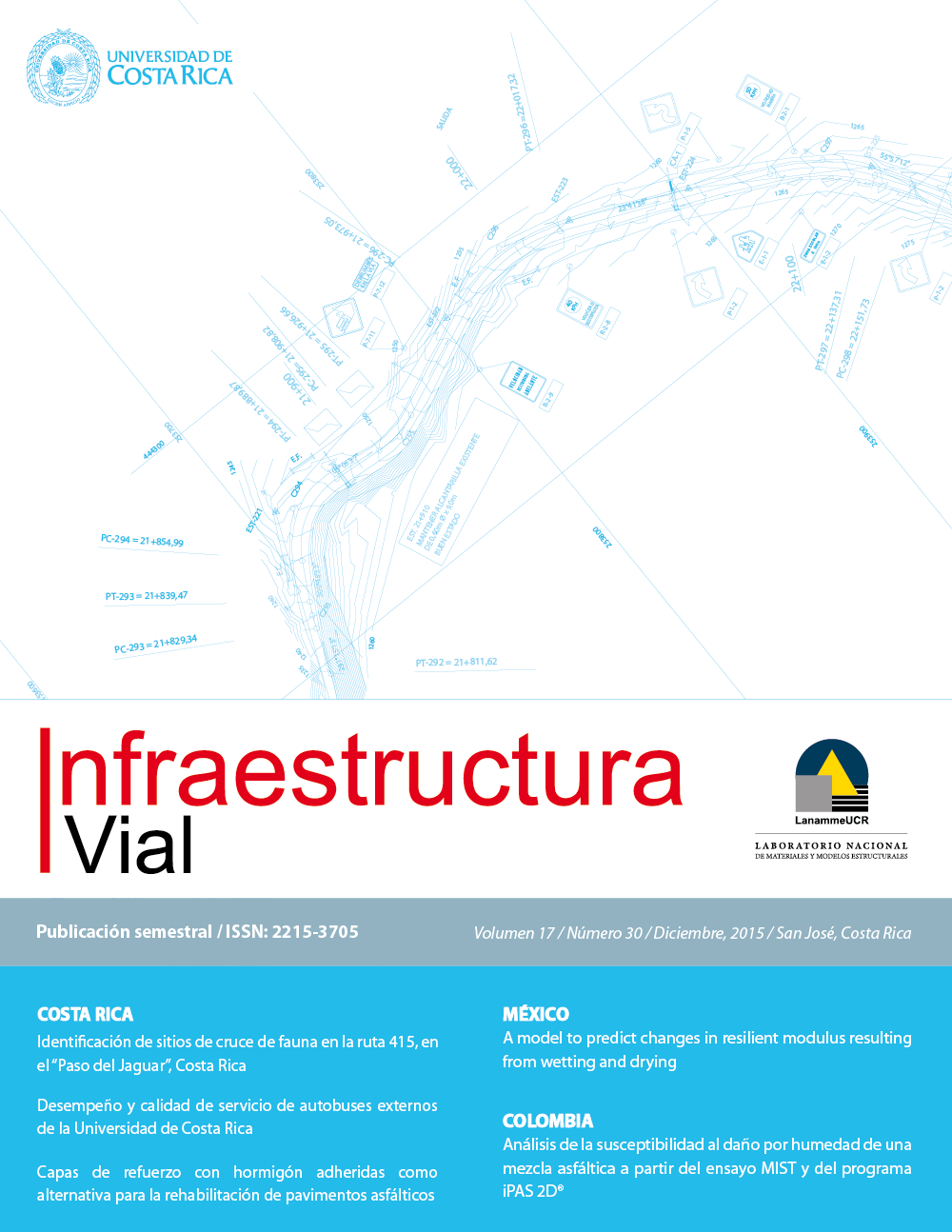Resumen
El módulo de resiliencia es uno de los parámetros más importantes para el diseño de pavimentos, sin embargo, éste no se mantiene constante después de la construcción de la obra sino que presenta cambios estacionales debidos a humedecimiento o secado de los materiales. Por tanto, los cambios en este parámetro deben ser contemplados en el diseño. La literatura sobre este tema es amplia para países extranjeros, sin embargo, para México es escasa. En este artículo los autores muestran resultados de una investigación cuyo objetivo fue obtener un modelo para predecir los cambios en el módulo de resiliencia debidos a humedecimiento o secado de suelos como arcillas, limo y arena. La metodología fue preparar varios especímenes en el óptimo de compactación (con respecto a la prueba Proctor estándar); posteriormente varios especímenes se humedecieron por capilaridad y otros se secaron al aire, con el propósito de simular condiciones posteriores a la construcción. Después del acondicionamiento de los especímenes, éstos fueron ensayados en la prueba de módulo de resiliencia de acuerdo con el protocolo NCHRP 1-28A. Los resultados indicaron que el módulo de resiliencia puede predecirse usando un modelo en función del esfuerzo desviador y del confinamiento (sd/s3) y la variación del contenido de agua con respecto a la humedad óptima. Al graficar los datos de módulo de resiliencia obtenidos en laboratorio contra los predichos con el modelo se obtuvo un valor de coeficiente de correlación (R2) de 84.1%, lo cual indica que el modelo es adecuado para predecir este parámetro.Citas
Baladi, G.Y., Dawson, T.A., and Haider, S.W. (2009). Laboratory Subgrade Resilient Modulus Design Values for the State of Michigan. 88th Transportation Research Board Annual Meeting. Washington D.C.
Baladi, G.Y., Sessions, C.P., and Haider, S.W. (2009). Backaclculated and Laboratory Measured Resilient Modulus Values. 88th Transportation Research Board Annual Meeting. Washington D.C.
Bayomy, F., El-Badawy, S., Awed, A. (2012). Implementation of the MEPDG for Flexible Pavements in Idaho. Report No. FHWA-ID-12-193. National Institute dor Advanced Transportation Technology, University of Idaho. Prepared for Idaho Transportation Division of Highways, Resource Center. May 2012.
Brown, S.F. (1996). Soil Mechanics in Pavement Engineering. Géotechnique 46. No. 3. Pp. 383-426.
Bulut, R., Muraleetharan, K.K. M., Zaman, M., Yue, E., Soltani, H., and Hossain, Z. (2013). Evaluation of the enhanced integrated climatic model for modulus-based construction specification for Oklahoma Pavements. Oklahoma Transportation Center. Report No. OTCREOS11.1-10-F.
Chen, D.H., Zaman, M.M., and Luguros, G. (1994). Resilient Moduli of Aggregate Materials: Variability due to Testing Procedure and Aggregate Type. Transportation Research Record 1462. Pp. 57-64.
Hossain, M. S. and Kim, W.S. (2014). Estimation of Subgrade Resilient Modulus Using the Unconfined Compression Test. Final Report: VCTIR 15-R12. Virginia Center for Transportation Innovation and Research.
Hossain, M.S. (2009). Estimation of Subgrade Resilient Modulus for Virginia Soil. 88th Transportation Research Board Annual Meeting. Washington D.C.
Jones, M. P., and Witczak, M.W. (1997). Subgrade Modulus on the San Diego Test Road. Transportation Research Record 641, Transportation Research Board, National Research Council, Washington, D.C. (1977). Pp. 1-6.
Khoury, N., Brooks, R. Musharraf, Z.M., and Khoury, N.C. (2009). Variations of Resilient Modulus of Sub-grade Soils with Post-Compaction Moisture Contents. 88th Transportation Research Board Annual Meeting. Washington D.C.
Khoury, C., Khoury, N., and Miller, G. (2011). Effect of cyclic Suction History (Hydraulic Histeresis) on Resilient Modulus of Unsaturated Fine-Grained Soil. 90th Transportation Research Board Annual Meeting. Washington D.C.
Lee, W., Bohra, N.C., Altschaeffl, A.G., and White, T.D. (1997). Resilient Modulus of Cohesive Soils. Journal of Geotechnical and Geoenvironmental Engineering. Vol. 123. No. 2. February, 1997. Pp. 131-135.
Mohammad, L.N., Huang, B., Puppala, A., and Allen, A.J. (1999). Regression moldel for Resilient Modulus of Subgrade Soils. Transportation Research Record 1687. Pp. 47-54.
Mohammad, L.N., Puppala, A.J., and Alavilli, P. (1994). Influence of Testing Procedure and LVDT Location on Resilient Modulus of Soils. Transportation Research Record 1462. Pp. 91-101.
Moossazadeh, J., and Witczak, M.W. (1981). Prediction of Subgrade Moduli for Soil that Exhibits Nonlinear Behavior. Transportation Research Record 810. Transportation Research Board, National Research Council, Washington, D.C.
Muhanna, A.S., Rahman, M.S., and Lambe, P.C. (1998). A model for Resilient Modulus and Permanent Strain of Subgrade Soils. Transportation Research Record 1619. Pp. 82-93.
Nazarian, S., Feliberti, M. (1993). Methodology for Resilient Modulus on Cohesionless Subgrade Soils. Transportation Research Record 1406. Pp. 108-115.
NCHRP. Laboratory Determination of Resilient Modulus for Flexible Pavement Design. National Cooperative Highway Research Program (NCHRP). Transportation Research Board of National Academies. Washington, 2004.
Rahim, A.M. and George, K.P. (2005). Models to estimate subgrade resilient modulus for pavement design. The International Journal of Pavement Engineering. Vol. 6. No. 2. June 2005. Pp. 89-96.
Santha, B. L. (1994). Resilient modulus of subgrade soils: Comparison of two Constitutive Equations. Transportation Research Record 1462: Soils, Geology and Foundations. Transportation Research Board.
Sawansuriya, A., Edil, T.B., and Benson, C.H. (2009). Effect of Suction on the Resilient Modulus of Compacted Fine-Grained Subgrade Soils. 88th Transportation Research Board Annual Meeting. Washington D.C.
Seed, H. B., Chan, K., and Monismith, C. L. (1955). Effects of Repeated Loading on the Strength and Deformation of Compacted Clay. A paper prepared for presentation at the annual meeting of the Highway Research Board. January 11-14, 1955. Washington, D.C.
Soliman, H., and Shalaby, A. (2011). Developing Pavement Design Inputs for Fine-Grained Subgrade Soils in Manitoba. 90th Transportation Research Board Annual Meeting. Washington D.C.
Taamneh, M.M. and Liang, R.Y. (2011). Predicting Stress and Moisture Dependent Resilient Modulus of Cohesive Soils. 90th Transportation Research Board Annual Meeting. Washington D.C.
Thompson, M.R., and Robnett, Q.L. (1979). Resilient Properties of Subgrade Soils. Transportation Engineering Journal of ASCE. Vol. 105. No. TE1 (January 1979). Pp. 71-89.
Uzan, J. (1985). Characterization of Granular Material. Transportation Research Record No. 1022. Pp. 52-59.


